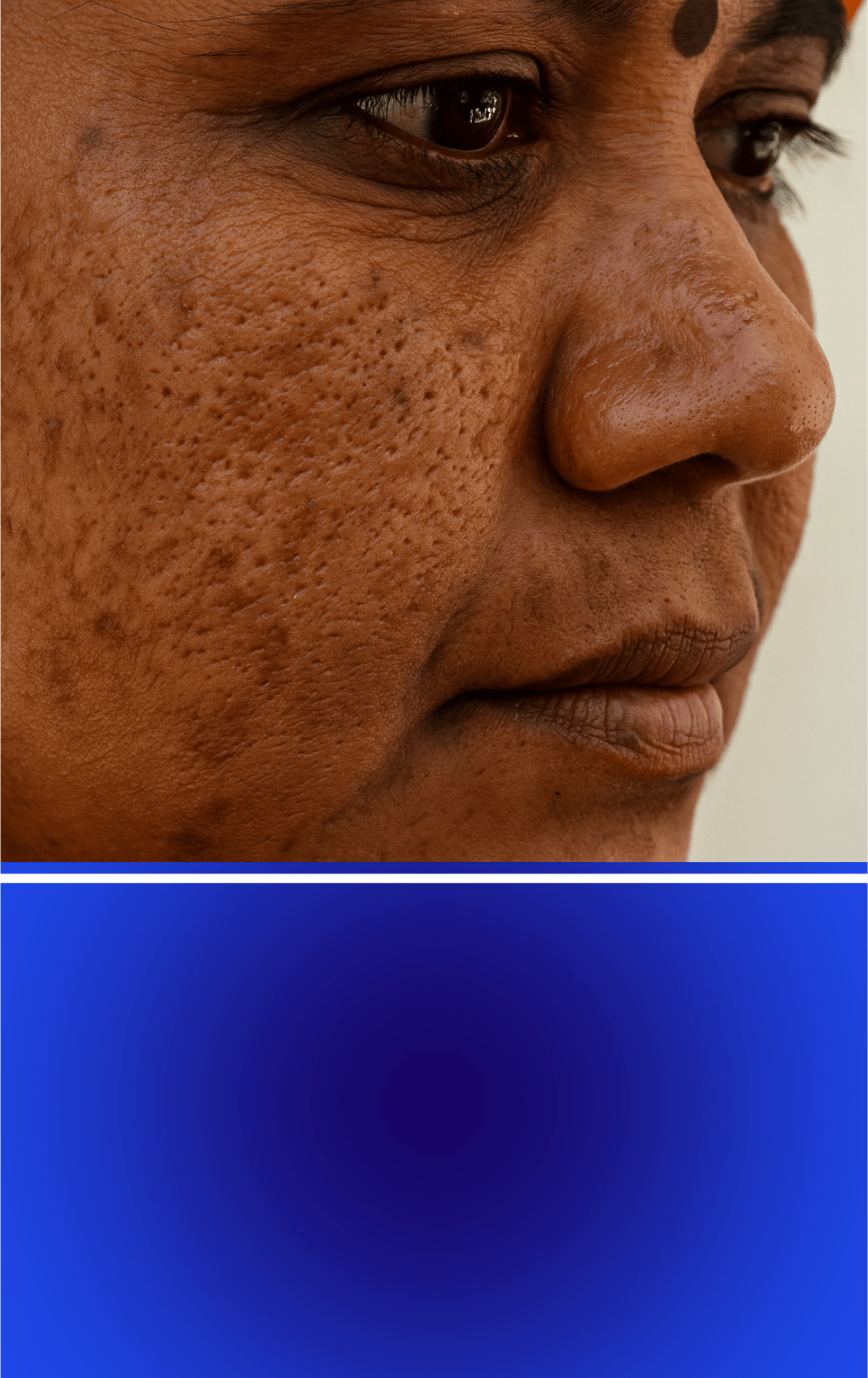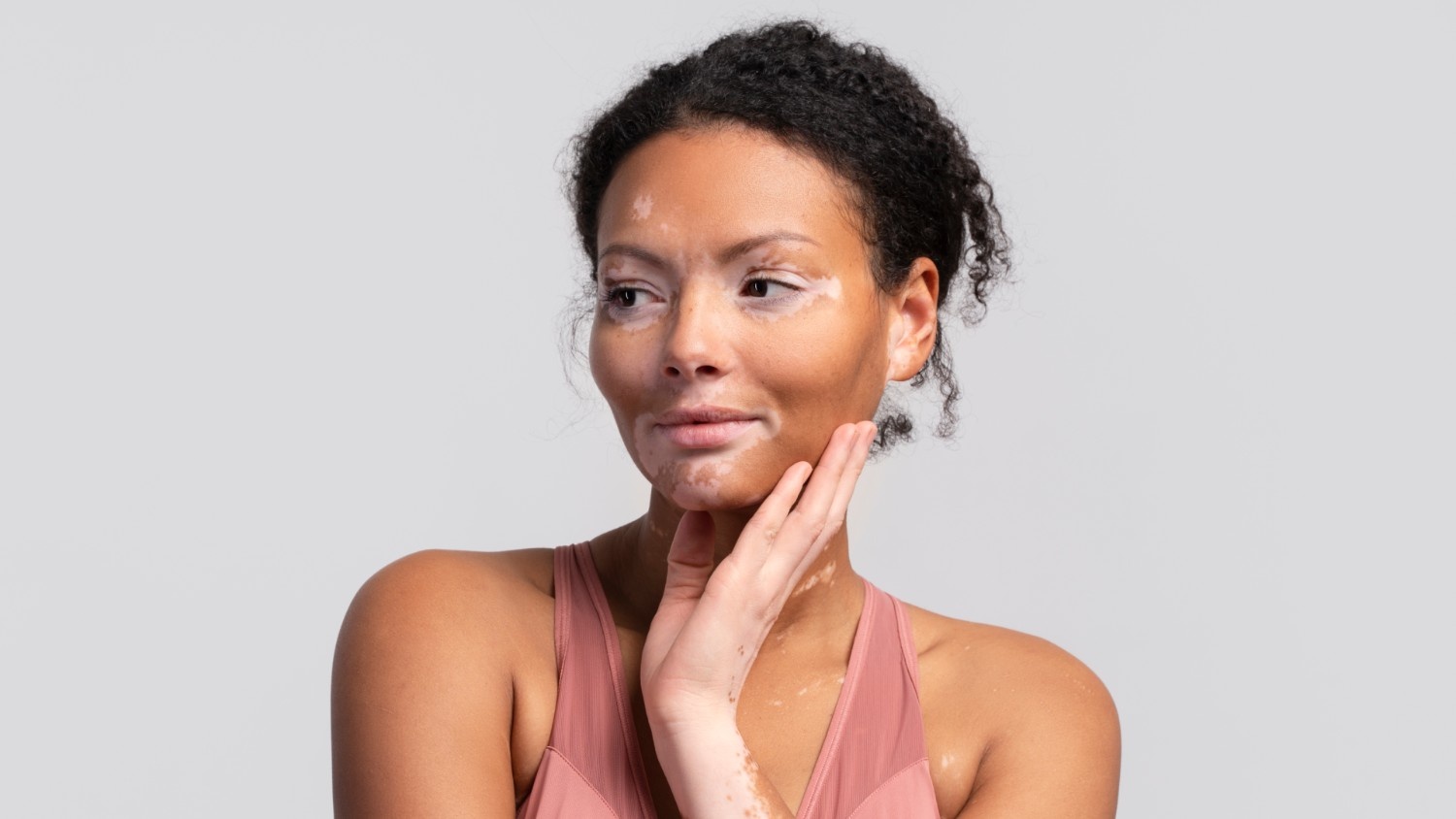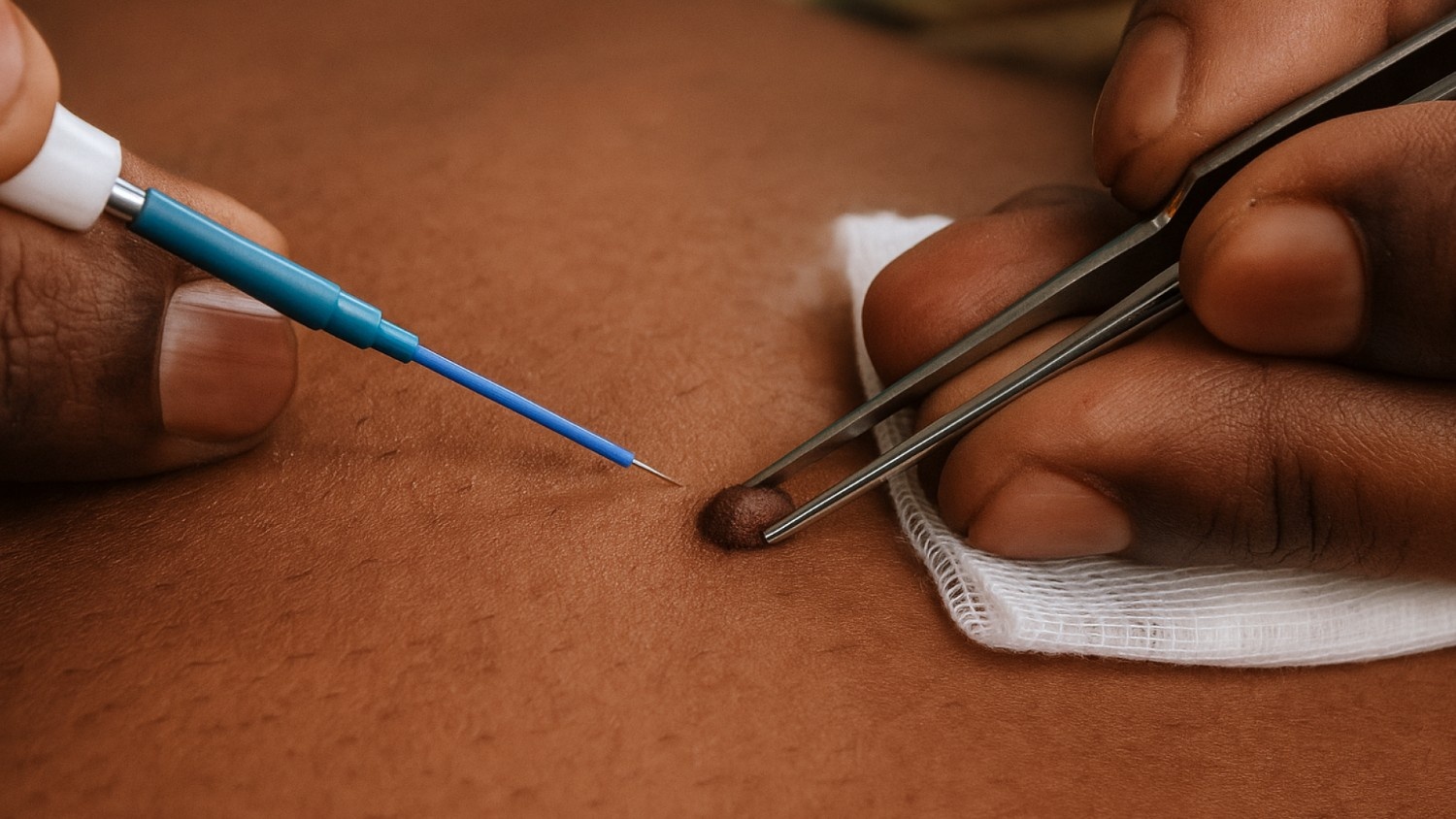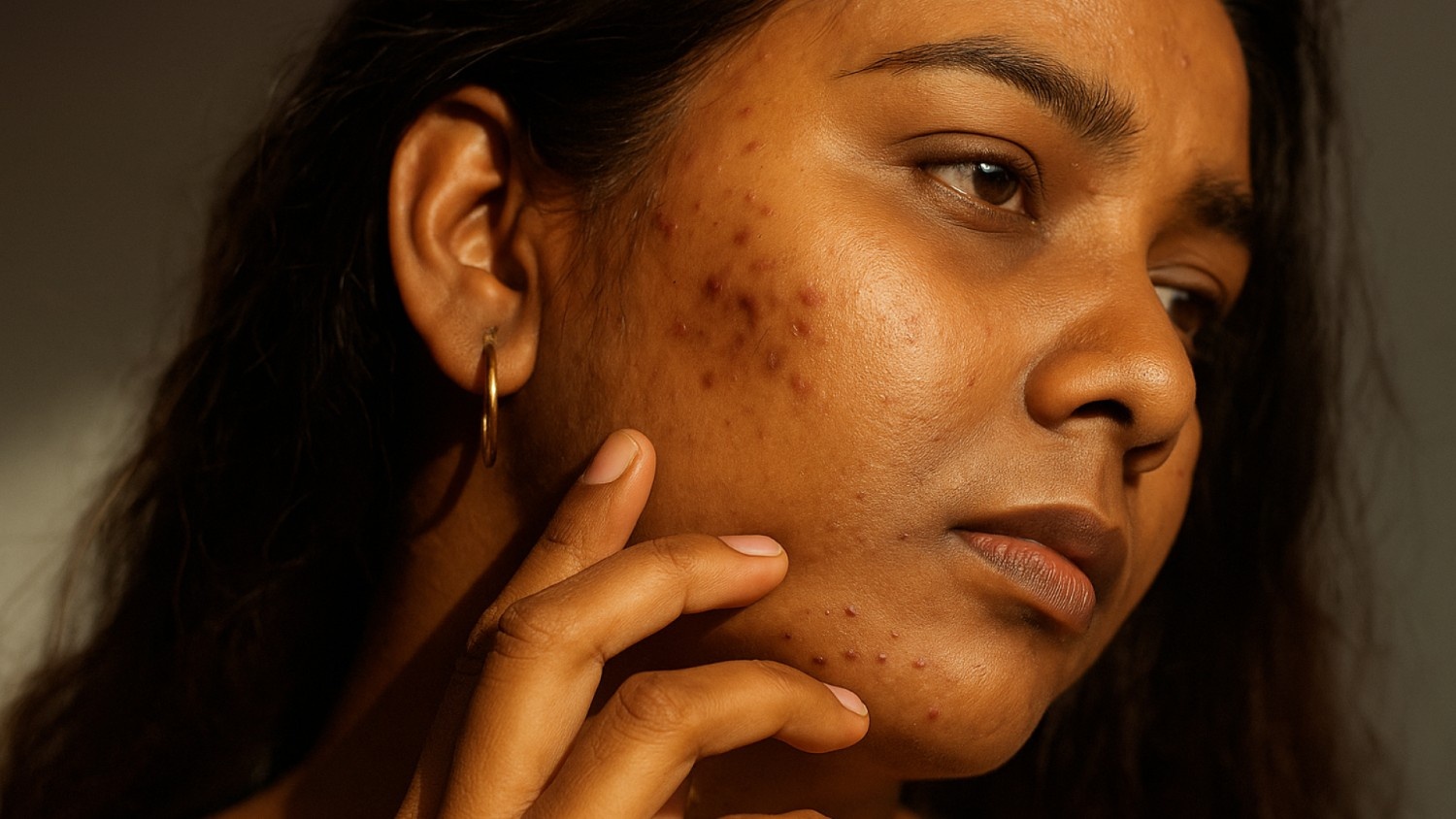It’s natural to feel a sense of worry when you suddenly notice white spots on your child’s face. You might start questioning whether it’s due to a vitamin deficiency, a skin condition, or something more serious. These spots can appear slowly over time or seem to show up overnight, and while some may fade on their own, others might persist and need professional attention.
Often, they result from changes in melanin production, caused by disrupted melanocytes, the cells responsible for skin pigmentation. In India, one such condition, vitiligo, is relatively common, with prevalence rates ranging from 0.4% to 8.8%. This variation is likely due to the country’s ethnic and environmental diversity across different regions.
In this blog, you’ll learn what white spots on a child’s face are and what causes them. You’ll also find out when to see a dermatologist, available treatments, and safe home care options.
Overview
- White spots on a child’s face can result from conditions like pityriasis alba, milia, or fungal infections.
- Vitamin deficiencies, especially calcium, vitamin D, and B12, are key causes behind white spots on the face of a child vitamin deficiency.
- Gentle skincare, sun protection, and balanced nutrition often help manage and prevent these spots.
- Medical treatments may be needed for persistent or unclear cases, consulting a dermatologist ensures a correct diagnosis.
- At Velantis Dermatology, all treatments are led by MD dermatologists, offering science-backed, ethical care for your child’s skin.
What Are White Spots on the Skin?
White spots on a child’s face are areas where the skin loses its normal pigmentation. These spots often appear lighter than the surrounding skin and may vary in size, shape, and texture. In most cases, they are not itchy or painful, but their presence can understandably raise concerns about underlying health or skin conditions.
What Causes White Spots on a Child’s Face?
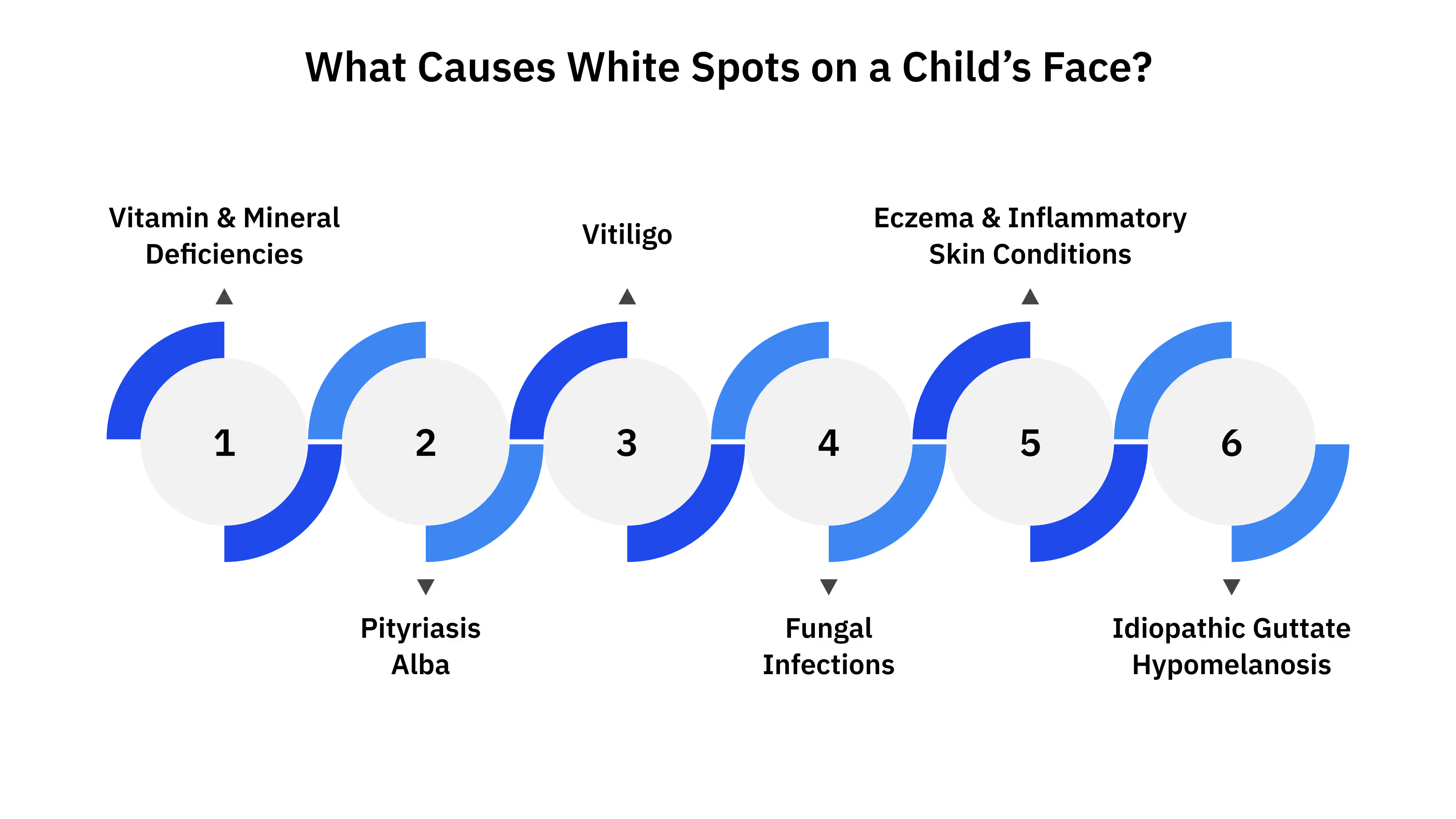
White spots on a child’s face can develop for several reasons. These may include vitamin and mineral deficiencies, skin-related conditions, infections, or immune responses. Here are some of the most common causes:
1. Vitamin and Mineral Deficiencies
Some of the most common causes are nutritional. A lack of certain vitamins and minerals can disrupt normal melanin production, the pigment that gives skin its colour.
- Vitamin B12 Deficiency: This vitamin plays an essential role in melanin production. When levels are low, it can lead to lighter patches where melanin is reduced.
- Vitamin D Deficiency: Often linked to limited sun exposure or dietary gaps, a lack of vitamin D may contribute to changes in skin pigmentation.
- Calcium Deficiency: Calcium supports both skin and bone health and works closely with vitamin D. Its deficiency may be linked to uneven pigmentation.
- Vitamin E Deficiency: As an antioxidant, vitamin E helps maintain skin structure. A shortage can lead to patchy or uneven skin tone.
2. Pityriasis Alba
Pityriasis alba is a common condition in children and usually appears as pale, slightly scaly patches on the face.
- It is considered a mild form of eczema and may be influenced by sun exposure, dry skin, or low vitamin D levels.
- Although harmless, the patches may last for several months before fading naturally.
3. Vitiligo
Vitiligo occurs when the body’s immune system attacks melanocytes, the cells that produce pigment, leading to defined white patches.
- These patches are often more visible after sun exposure since the affected skin does not tan like the surrounding area.
- The condition may begin in childhood and usually requires medical attention to monitor progression.
4. Fungal Infections (Tinea Versicolor)
Tinea versicolor is a superficial yeast infection that can cause lighter spots on the face or upper body. The affected areas may appear more prominent after sun exposure because the skin doesn’t tan evenly. This condition generally responds well to prescribed antifungal treatments.
5. Eczema and Inflammatory Skin Conditions
When a child has eczema or similar inflammatory skin issues, the affected skin may lose pigment temporarily once the inflammation improves. This can result in lighter or white spots, especially if the skin becomes dry or begins to flake.
6. Idiopathic Guttate Hypomelanosis
Though more common in adults, this condition can occasionally affect children who are frequently exposed to the sun.
- It presents as small, white dots on the skin, usually in areas exposed to sunlight.
- While not harmful, the appearance may cause concern and should be evaluated if persistent.
When to Consult a Dermatologist for White Spots on a Child’s Face?
While many white spots on a child’s face are harmless and temporary, there are situations where a professional evaluation is necessary. You should consider consulting a dermatologist if:
- No Improvement Over Time: If the white spots do not fade or change after several weeks, it may indicate a deeper issue that needs attention.
- Spots Are Spreading or Increasing: An increase in size or number of white patches may point to a progressive condition, such as vitiligo or an untreated infection.
- Visible Skin Irritation: If the area around the white spots appears red, itchy, flaky, or scaly, a dermatologist should evaluate the skin for inflammation or infection.
- Known Nutritional Deficiencies: Children with a restricted diet or diagnosed deficiencies in vitamin B12, D, or calcium may be more prone to pigment changes and should be assessed.
- Other Health Symptoms Present: Watch for additional signs like fatigue, delayed growth, or unusual skin texture, which may suggest a broader nutritional or medical concern.
- Unusual Shape or Pattern: Spots that are clearly defined, asymmetrical, or irregular may require a closer examination to rule out vitiligo or other dermatological conditions.
- Sun Exposure or Extremely Dry Skin: Prolonged exposure to the sun or very dry skin can worsen white patches. In such cases, a dermatologist can recommend appropriate skin care and protection.
Unsure what’s causing white patches on your child’s face? Velantis Dermatology provides expert care to diagnose and treat skin issues linked to vitamin deficiencies and more. Start your child’s skin health journey by consulting with us.
Medical Treatments for White Spots on a Child’s Face
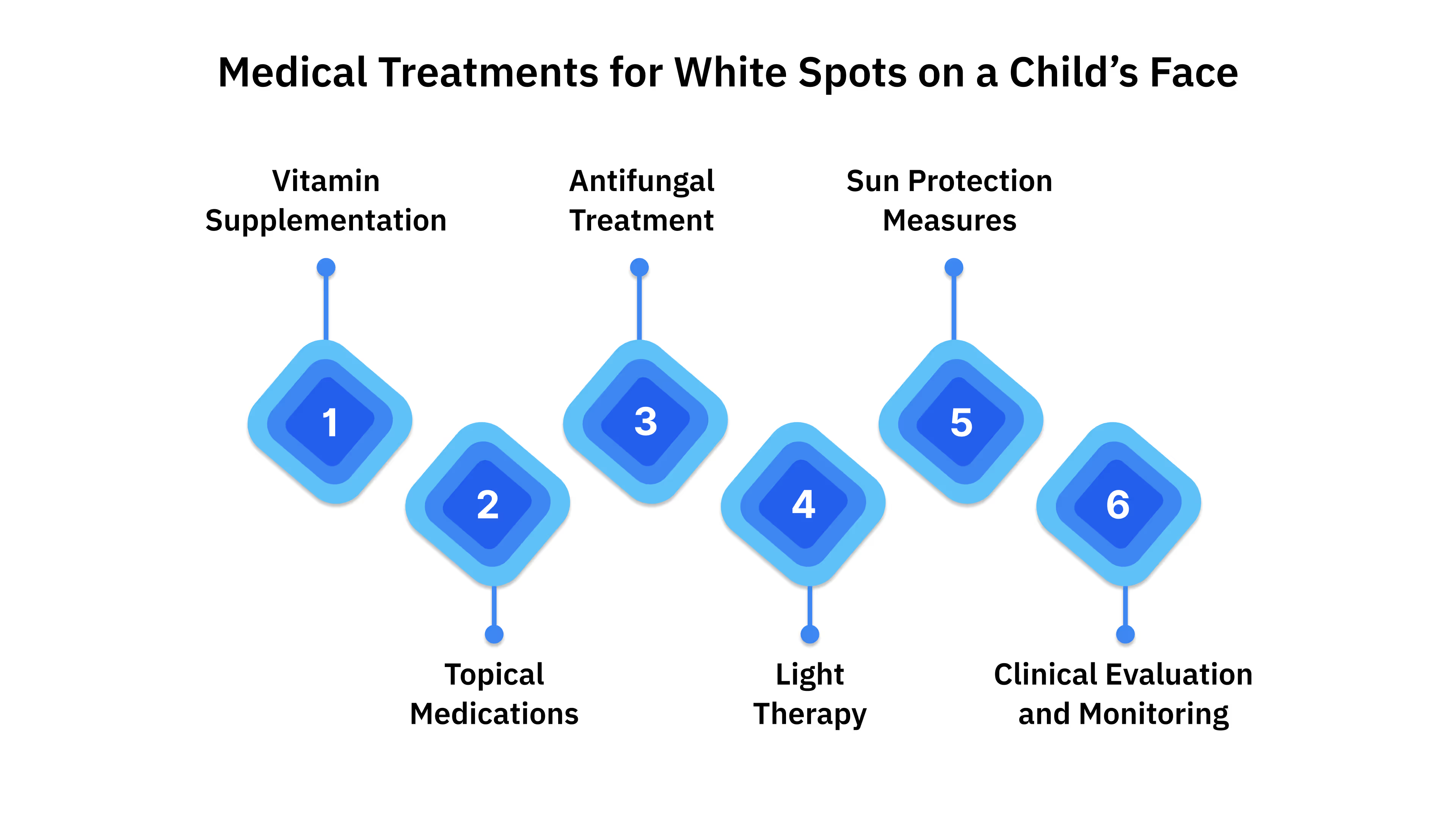
White spots on a child’s face can result from several medical causes, and addressing them effectively often requires targeted treatment based on an accurate diagnosis. Here are some of the commonly recommended treatments:
1. Vitamin Supplementation
If tests confirm that the white spots are related to low levels of vitamins like B12, D, or E, your child’s doctor may suggest appropriate supplements. Alongside this, including more vitamin-rich foods in your child’s diet, such as fortified milk, eggs, and leafy green vegetables, can help support healthy skin function and gradual repigmentation.
2. Topical Medications
For common conditions like pityriasis alba, applying fragrance-free moisturisers regularly helps to improve skin hydration and reduce dryness. In some cases, a dermatologist may recommend prescription creams, such as mild corticosteroids or non-steroid options like tacrolimus or pimecrolimus, to manage inflammation and support pigment recovery.
3. Antifungal Treatment
If a fungal infection such as tinea versicolor is the cause, antifungal creams or medicated shampoos containing agents like ketoconazole or selenium sulphide are often used. For more persistent or widespread infections, oral antifungal medications like fluconazole may be prescribed by the treating specialist.
4. Light Therapy (Phototherapy)
In certain cases, such as vitiligo or when pigment loss is more extensive, phototherapy using narrowband UVB light may be considered. This involves scheduled, controlled exposure to specific wavelengths of ultraviolet light, which can help restore pigment and stabilise changes in the skin over time. The treatment is usually carried out two to three times a week under clinical supervision.
5. Sun Protection Measures
Skin affected by white spots is often more sensitive to sunlight. Using a broad-spectrum sunscreen with SPF 30 or higher every day is essential to protect these areas. Encouraging sun safety, such as avoiding peak sunlight hours, can prevent further pigment loss or skin irritation.
6. Clinical Evaluation and Monitoring
Because white spots can have different causes, it’s important to get a clear diagnosis from a medical professional. This may involve skin examination and blood tests to check vitamin levels. Conditions like vitiligo often need regular follow-up to manage any progression and to adjust treatment if needed.
For expert care in diagnosing and treating white spots on the face of a child due to vitamin deficiency or skin conditions, trust the specialists at Velantis Dermatology. Book a consultation today with Dr. Janani Sree C M, our MD Dermatologist, to get personalised, child-friendly treatment solutions.
Remedies and Natural Care Tips for White Spots on a Child’s Face
In addition to medical treatment, certain natural care measures may help support your child’s skin health and encourage gradual improvement in pigmentation. The following are some commonly used approaches that can be considered alongside clinical advice:
1. Nutritional Support
A healthy diet is one of the most important steps you can take to support your child’s skin from within. Below are some nutritional suggestions:
- Include Vitamin-Rich Foods: Add sources of vitamins B12, D, and E to your child’s meals. This includes milk, eggs, fish, leafy greens, and fortified cereals.
- Address Dietary Gaps: For children with limited food preferences, consider discussing nutritional planning with a paediatrician or dietitian.
- Support melanin production: A well-balanced diet helps maintain healthy pigmentation and overall skin function.
2. Safe Sun Exposure
Moderate sun exposure can benefit your child’s vitamin D levels and skin health. Here are some safe practices to follow:
- Encourage Outdoor Time: Limited morning or late afternoon sun exposure helps the body produce vitamin D, which supports skin health.
- Avoid Peak Sunlight: Keep your child out of direct sunlight during midday hours to reduce the risk of sunburn or skin damage.
- Use Sun Protection When Needed: If exposure is unavoidable, apply child-safe sunscreen to prevent worsening of white patches.
3. Gentle Topical Remedies
Natural topical options may help soothe your child’s skin and support repair. Below are some commonly used remedies:
- Coconut Oil: Gently massage onto affected areas once or twice daily to reduce dryness and support skin barrier repair.
- Aloe Vera Gel: Apply a thin layer of pure aloe vera gel on white patches daily to promote cell renewal and soothe the skin.
- Turmeric and Coconut Oil Paste: Mix a small amount of turmeric with coconut oil, apply for 15–20 minutes, then rinse. Use caution and patch tests first.
4. Traditional Herbal Practices
Some herbal remedies, rooted in traditional care, are believed to help support skin balance. Here are a few that are commonly used:
- Tulsi (Holy Basil): Chewing a few fresh tulsi leaves or using tulsi-infused water may support skin immunity due to its natural antimicrobial properties.
5. Additional Care Measures
Simple lifestyle adjustments and general skin care can help prevent irritation and support healing. Consider the following tips:
- Use Mild Cleansers: Avoid soaps with strong fragrances or harsh chemicals that may irritate the skin.
- Keep Skin Hydrated: Ensure your child drinks enough water and uses a suitable moisturiser to maintain healthy skin moisture levels.
- Be Cautious with Copper: Drinking from copper vessels is a traditional practice believed to help melanin production. If used, do so in moderation and under guidance.
Conclusion
As explored throughout this blog, white spots on a child’s face can result from several factors, including common skin conditions, sun exposure, and nutritional deficiencies. In particular, white spots on the face of a child vitamin deficiency remains one of the most frequently observed concerns in paediatric dermatology. Addressing these issues early, through balanced nutrition, gentle care, and professional assessment, can support healthy skin recovery over time.
At Velantis Dermatology, each case is approached with clinical precision, medical integrity, and deep respect for a child’s unique dermatological needs. Founded by Dr. Janani, the clinic stands apart by offering only evidence-based, doctor-led care, free from cosmetic fads or aggressive sales tactics.
Every consultation is handled by an experienced MD Dermatologist, ensuring that your child receives an accurate diagnosis and ethical treatment options based on science, not trends.
Book a Consultation with Velantis's Chief Dermatologist, Dr. Janani Sree C M, and receive trusted care rooted in science and delivered with compassion.
FAQs
Q1. Do white spots always mean vitiligo?
A1. Not necessarily. While vitiligo is one possible cause, white spots can also result from fungal infections, minor skin conditions, or vitamin deficiencies. Vitiligo is an autoimmune issue where pigment cells stop functioning, but in children, other causes are far more common and often temporary. A dermatologist can help you identify the exact reason.
Q2. Can white spots be caused just by vitamin deficiencies?
A2. Yes, they can. Deficiencies in vitamins like B12, D, E, or even minerals like calcium, can lead to visible changes in skin pigmentation. These nutrients are essential for maintaining healthy skin tone. Still, other factors, like infections or inflammatory skin conditions, can also lead to similar white patches. A thorough medical evaluation is important.
Q3. How long will it take for the white spots to go away?
A3. That depends on the cause. If a vitamin deficiency is involved, you may notice improvement within weeks to a few months once the right supplements and dietary changes are in place. Conditions like pityriasis alba often resolve gradually on their own. However, if the underlying cause is vitiligo, treatment may focus more on management than reversal.
Q4. What other skin problems can lead to white patches on a child’s face?
A4. Several skin conditions may present as white spots. These include pityriasis alba (dry, pale patches), fungal infections, eczema, milia (tiny white bumps), and sun-induced pigmentation changes. Each condition has different signs and requires a specific treatment approach.
Q5. Are these white patches contagious?
A5. In most cases, no. White spots caused by nutritional deficiencies, vitiligo, or non-infectious skin conditions are not contagious. However, if the patches are due to a fungal infection, they could spread without treatment and may need antifungal care.
Q6. Can sun exposure make these spots worse?
A6. Yes, in some cases. Sunlight may highlight the contrast between normal and depigmented skin, especially in conditions like vitiligo or tinea versicolor. It can also cause irritation or damage to already sensitive skin. Using sun protection is advisable while observing any changes in your child’s skin.
Q7. Should I change my child’s diet if white spots appear?
A7. If a vitamin deficiency is confirmed or suspected, improving your child’s diet can support recovery. Foods rich in vitamins B12, D, and E, along with adequate calcium, play a key role in skin health. A doctor may also recommend supplements. Always seek guidance from a paediatrician or dermatologist before making dietary changes.
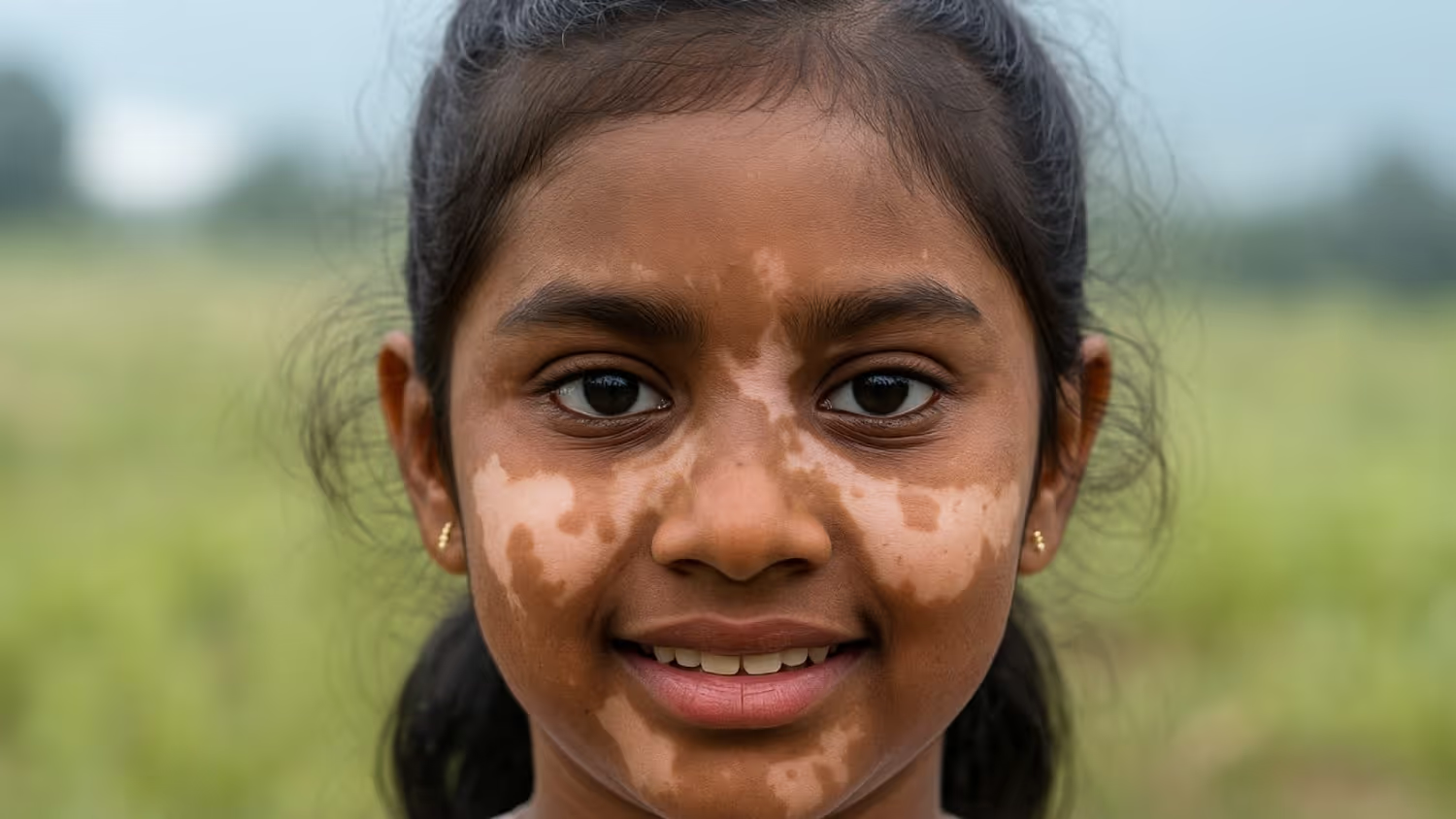

.png)
